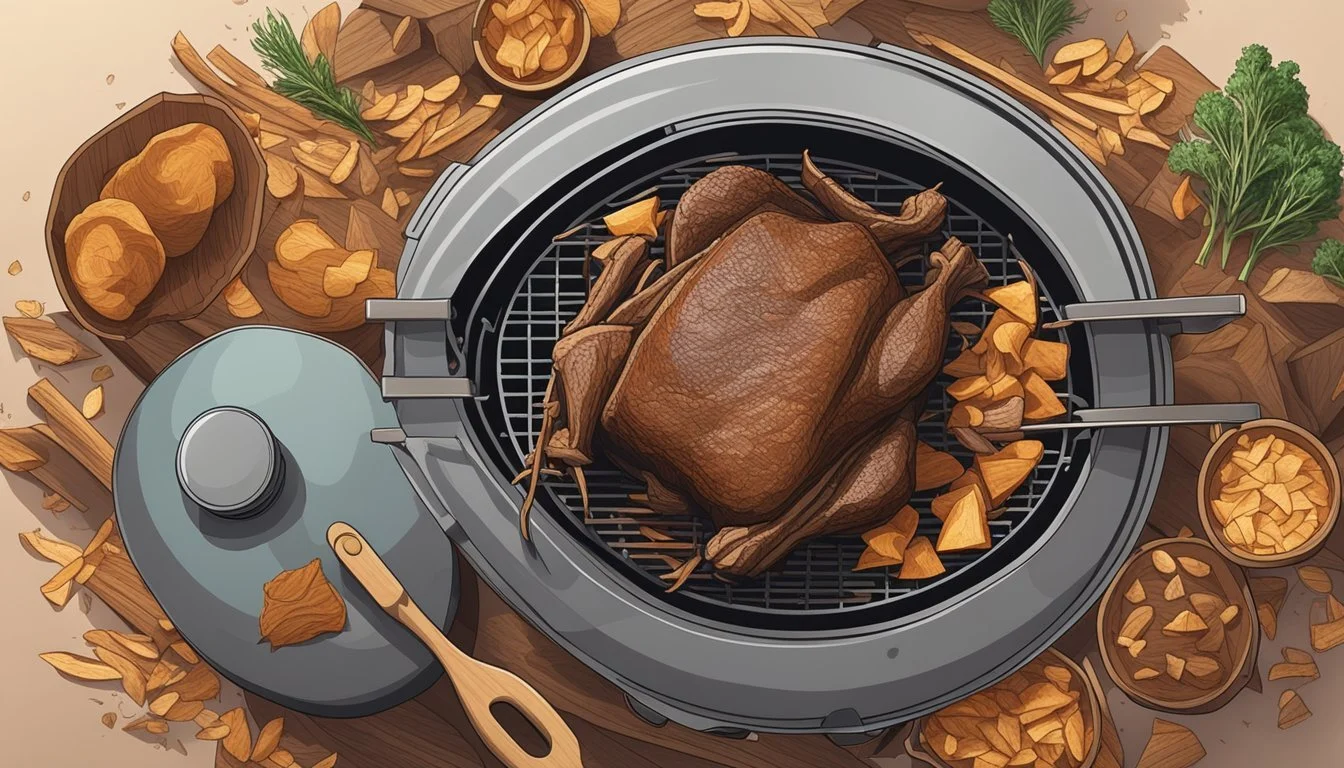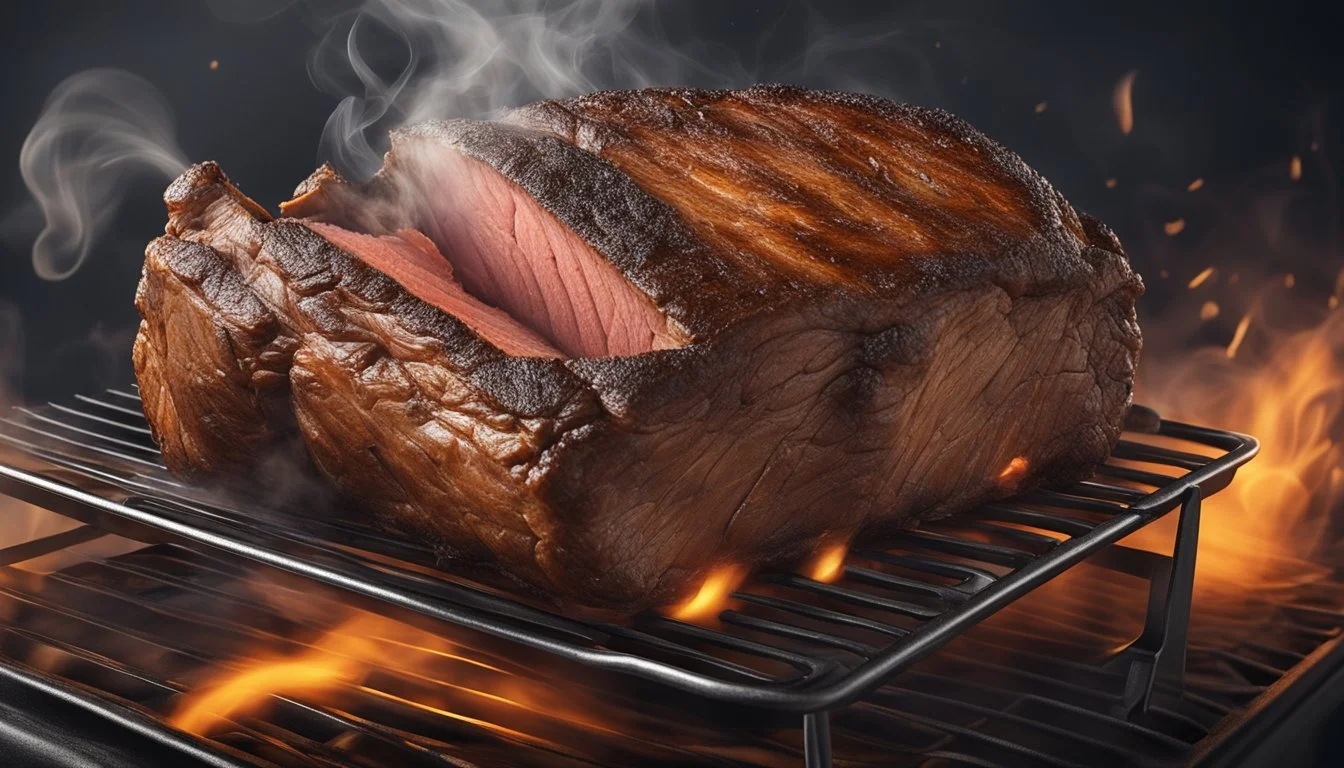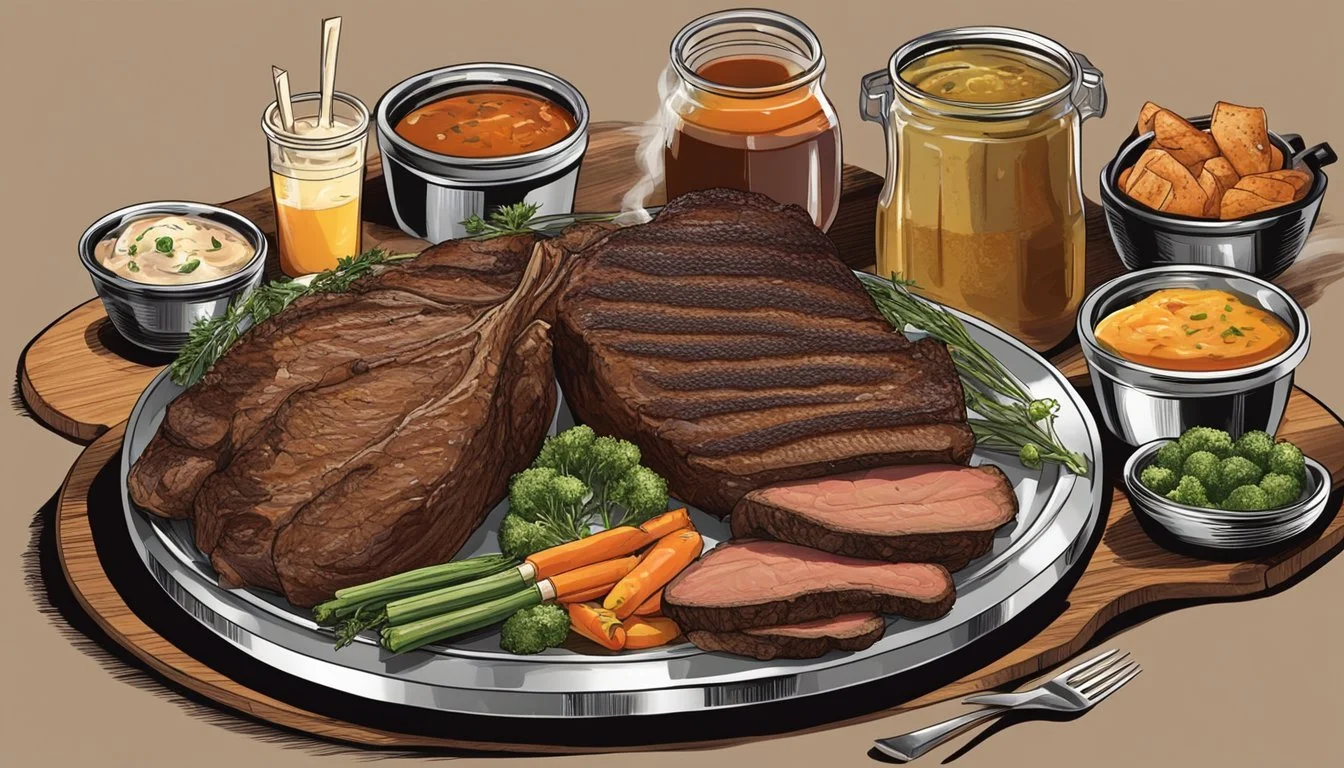Mastering Smoked Chuck Roast
Taking Your Beef to the Next Level
Taking a classic beef (What wine goes well with beef?) chuck roast and elevating it to an exquisite level of flavor and tenderness is an art in itself. The smoking process offers a unique opportunity to infuse a robust, smoky flavor into the beef, transforming a simple piece of meat into a truly memorable dish. This technique relies on low and slow cooking, allowing the cut's connective tissue to break down, resulting in a tender and juicy meal.
Key to the process is managing the internal temperature, as it guides the cook to the precise moment when the meat reaches its peak of perfection. Typically, a target temperature of about 190°F to 200°F is ideal for a smoked chuck roast. To maintain moisture and enhance the beefy flavor, a touch of beef broth can be added during the smoking, wrapping the roast in heavy duty aluminum foil if needed to preserve those precious juices.
One can utilize various types of wood to impart different smoky nuances—a hint of sweet applewood, the hearty scent of oak, or the nutty whispers of pecan wood. The choice of wood, just like the selection of seasonings such as kosher salt (how long does kosher salt last?) and garlic powder, (how long does garlic powder last?) contributes significantly to the final flavor profile, making each smoked chuck roast an opportunity to create a unique culinary masterpiece.
Selecting a Quality Chuck Roast
When smoking chuck roast to enhance its rich beef flavor, the initial selection and preparation are vital. The right cut and trimming technique lay the foundation for a mouth-watering, tender, and juicy result.
Choosing the Right Cut of Meat
Beef Chuck: Often used for pot roast, this cut comes from the cow's shoulder. It contains generous marbling and connective tissue, which, when cooked slowly, contribute to the meat's tenderness and juicy qualities. Look for a piece of meat that is:
Even in thickness to ensure consistent cooking.
Rich in color with a substantial amount of white marbling.
Internal Temperature: For smoking, aim for an internal temperature of 195°F to 205°F. This range helps break down the connective tissue without drying out the meat.
Types of Wood: The choice of wood impacts the smoky flavor. Hickory, mesquite, oak wood, or pecan wood are popular choices that complement beef. Different types of wood impart their unique flavor profiles:
Hickory:
Flavor Profile: Strong, bacon-like
Mesquite:
Flavor Profile: Intense, earthy
Oak:
Flavor Profile: Medium, smoky
Pecan:
Flavor Profile: Mild, nutty, sweet
Trimming and Prepping the Roast
Before smoking, trim excess fat to about 1/4-inch thickness to aid in forming a desirable bark. Season the roast generously with a mix of kosher salt, garlic powder, and pepper. These simple seasonings enhance the beefy flavor and assist in the formation of a crusty exterior. Do not overlook the importance of:
Patting the beef dry before seasoning to help the spices adhere.
Allowing the meat to sit with the seasonings for at least 30 minutes prior to cooking. This step aids in developing a more pronounced flavor throughout the meat.
Using the Right Wood for Smoking
Choosing the right wood for smoking a chuck roast is pivotal as it significantly influences the meat's flavor profile. The type of wood used can either complement the beefy flavor of the roast or overpower it.
Popular Wood Choices
There are several types of wood suitable for smoking beef chuck, and each imparts a different flavor:
Oak Wood: Offers a medium smoky flavor that's not overpowering, making it a versatile choice for beef.
Hickory: A classic choice that gives a robust, bacon-like smoky taste to meat.
Pecan Wood: Provides a sweet, nutty flavor and is milder than hickory.
Apple Wood: Delivers a subtle hint of sweetness and is ideal for balancing the rich beef flavor.
It's important to use dry, seasoned wood to prevent any acrid smoke that can ruin the quality of your smoked chuck roast.
Getting the Desired Smoke Flavor
To achieve the perfect smoke flavor:
Smoke Intensity: Adjust by the amount of wood used. Less wood results in a milder taste, while more can infuse a stronger flavor.
Combining Woods: Mixing woods like oak with cherry can balance strong and mild flavors, creating a unique taste profile.
Soaking Wood Chips: Soaking can prolong the smoking process and is recommended for grills and smokers that may burn wood too quickly.
When smoking a chuck roast, a rule of thumb is to maintain an internal temperature of around 190°F for a tender meat texture, as the connective tissue breaks down. This often requires a cooking time of about 2-3 hours. Remember, the smoking process, including the wood choice, contributes to the final moisture and tenderness of the meat, as well as the formation of a desirable bark. Always use a meat thermometer to ensure accurate meat cook without relying solely on hours per pound or external cues.
Setting Up Your Smoker or Grill
Properly setting up your smoker or grill is the first step toward achieving a rich, smoky flavor in your chuck roast. Attention to heat configuration, temperature control, grill preparation, and internal meat temperature is critical.
Configuring for Indirect Heat
For smoking a chuck roast, it's essential to configure your grill or smoker for indirect heat. In a charcoal grill, this involves placing coals on one side of the grill and the meat on the other. For pellet smokers or gas grills, use the designated settings to create a heat zone away from the meat. This method prevents direct flames from cooking the piece of meat too quickly and allows for an even, slow cook essential for breaking down the connective tissue to achieve tender, juicy meat.
Maintaining Temperature
Maintain a consistent temperature between 225° and 250° Fahrenheit during the smoking process; this is the sweet spot for transforming tough cuts into tender dishes. Depending on the type of smoker or grill, you may need to check the temperature every 30 minutes to an hour to make adjustments. Always have extra charcoal, wood chunks, or pellets ready to maintain heat. Common choices of wood that complement your cuts of beef include pecan wood, oak wood, or your favorite wood for a smokey delicious flavor.
Preparing the Grill Grates
Before placing the chuck roast on, ensure the grill grate is clean to prevent sticking and to achieve a nice crust, or bark, on the meat. Lightly oil the grates to further reduce sticking. When preparing your roast, season generously with garlic powder and kosher salt along with any other desired seasonings, to enhance the beefy flavor.
Using a Digital Meat Thermometer
Use a digital thermometer to check the internal temperature of the chuck roast throughout the cooking time. The goal is to reach an internal temperature that allows the connective tissues to break down without drying out the meat, typically around 190° to 205° Fahrenheit. Insert the temperature probe into the thickest part of the roast, avoiding fat and bone, to get the most accurate reading. Once the desired temperature is reached, wrap the meat in layers of foil or pink butcher paper and let it rest to allow the juices to redistribute.
Applying Rubs and Seasonings
Before smoking a chuck roast to perfection, it's crucial to understand the impact that rubs and seasonings have on enhancing the meat’s flavor and texture. Applying the right blend of spices creates not only a surface bark but also contributes to the overall tender and juicy experience of the final dish.
Dry Rubs vs Wet Marinades
Dry Rubs offer a concentrated flavor that, when applied, forms a crusty 'bark' on the meat, sealing in juices and creating a smoky flavor.
Ingredients: Common components include kosher salt, garlic powder, and various herbs and spices.
Application: Rub the spice mixture generously over the meat, pressing it onto the surface to adhere.
Advantages: Dry rubs contribute to a better-textured crust and typically do not add moisture, allowing for a smokier bark.
Wet Marinades, on the other hand, infuse the meat with moisture and flavor.
Ingredients: These may consist of beef broth, apple cider vinegar, or other liquids combined with seasonings.
Application: Submerge the chuck roast in the marinade and refrigerate, allowing a couple of hours for the flavors to penetrate.
Advantages: Marinades can tenderize the meat by breaking down connective tissue, leading to tender and juicy meat.
Herb and Spice Combinations
The choice of Herbs and Spices plays a pivotal role in imparting the desired profile to your smoked chuck roast.
Classic Blend: Combine kosher salt and black pepper with onion powder and garlic powder for a simple yet full-bodied flavor.
Complex Mixtures: Incorporate elements like smoked paprika, (how long does smoked paprika last?) brown sugar, or chili powder for deeper, more nuanced flavors.
Utilize Wood Chips to complement these seasonings:
Choice of Wood: Hickory and oak wood instill a robust smoky flavor, while apple or pecan wood offers a milder, sweeter note.
Smoking Process: Add wood chips directly to the heat source, whether using a charcoal grill, pellet smoker, or gas grill.
Remember, the type of rub or marinade and the choice of wood can radically alter the final taste of your dish, making it crucial to select these elements thoughtfully for your smoked chuck roast.
Estimating Cook Times
When aiming to enhance chuck roast through smoking, understanding the cook time is critical to achieve that perfect balance of tender and juicy meat.
Hours Per Pound Guidelines
The general rule for smoking meats like chuck roast is to allocate approximately 1.5 to 2 hours per pound of meat. This estimation is based on maintaining a smoker temperature of 225 to 250 degrees F. For instance, a 4-pound beef chuck could take about 6 to 8 hours of cook time.
Factors Affecting Cook Time
Several factors can influence the total cooking time:
Smoker type: Offsets, pellet grills, gas grills, and charcoal grills each maintain heat differently.
Meat thickness and weight: Thicker and heavier pieces require more time.
Desired doneness: Chuck roast is typically smoked until it reaches an internal temperature of 190 to 205 degrees F.
External conditions: Ambient temperature and wind can affect heat consistency.
Choice of wood: Different types of wood, like oak, hickory, or apple, burn at varying rates and impart unique flavors. Favorite woods include oak wood, pecan wood, and hickory.
Dealing with the Stall
The "stall" is a period where the meat's temperature plateaus, often happening around 150 to 160 degrees F. To counteract this:
Wrap the meat in pink butcher paper or aluminum foil. This can help retain moisture and push through the stall.
Use a temperature probe to monitor internal heat without lifting the smoker lid, which can prolong cooking.
Introduce a braising liquid, such as beef broth or apple cider vinegar, to add moisture and facilitate cooking through the stall phase.
Monitoring Doneness
Achieving the perfect level of doneness in a smoked chuck roast involves careful monitoring of internal temperature and tenderness to ensure the meat is both juicy and tender. Using the right tools and techniques can elevate the smoking process, ultimately delivering a richly flavored and succulent piece of meat.
Tracking the Internal Temperature
To accurately monitor the smoked chuck roast's doneness, a reliable meat thermometer is essential. Insert the temperature probe into the thickest part of the beef without touching any bone or fat. A general rule of thumb for smoking chuck roast is aiming for an internal temperature of around 190°F, as connective tissue breaks down at this heat, rendering the beef tender. Monitor the temperature periodically, remembering that cooking time can vary based on cuts of meat, weight, and your smoker's consistency.
Checking Tenderness
While internal temperature is a solid indicator of doneness, tenderness should not be overlooked. Over time, the connective tissue within the chuck roast will break down, and the meat should yield to gentle pressure. An additional method for testing this is by inserting a fork into the meat; it should twist easily and without resistance when the chuck roast reaches optimal tenderness.
Letting the Meat Rest
Resting is crucial to lock in the juices of the chuck roast, contributing to a juicy meat experience. After reaching the desired internal temperature, remove the beef from the smoker. Wrap the chuck roast in aluminum foil or pink butcher paper, and let it sit for at least 15 minutes. This pause allows the juices to redistribute throughout the meat, preventing them from running out when slicing.
Determining Doneness Visually
Assessing the chuck roast's appearance offers additional cues to its doneness. A well-smoked chuck roast will display a rich, caramelized bark on the exterior, a result of the rub formed from seasonings like kosher salt, garlic powder, and other spices mixed with the smoky flavor. The crust should appear dark, indicating a proper smoke flavor infusion, while the interior should no longer be pinkish but should have a succulent brownish hue, signifying a thorough cook.
Sauces, Sides and Serving
Preparing an impeccable smoked chuck roast extends beyond the smoking process to the complementary sauces, sides, and methods of serving. Mastery in these areas ensures a memorable dining experience that brings out the rich flavors of the meat.
Making Gravy from the Drippings
Transform the savory drippings from your smoked chuck roast into a delectable gravy. Begin by collecting the juices after the roast has finished cooking. Combine the drippings with beef broth in a saucepan, stirring in a tablespoon of flour to thicken. Simmer until it reaches the desired consistency, integrating the smoky essence of the roast into a perfect sauce.
Classic Roast Pairings
Ideal accompaniments to smoked chuck roast include dishes that balance the meat's robust character:
Potatoes: Roasted, mashed, or in a gratin.
Vegetables: Glazed carrots, green beans, or corn.
Starches: Rice pilaf, creamy polenta, or dinner rolls.
Complement the smoky flavor of the roast with these sides for a satisfying and well-rounded meal.
Slicing and Plating the Roast
After allowing the meat to rest—ensuring the juices redistribute for tender meat—slice the roast against the grain. Use a sharp knife to cut the beef into thin slices, making it easier to eat and presenting it appealingly on the plate. Serve with a drizzle of gravy and your chosen side dishes.
Leftover and Repurposing Ideas
Smoked chuck roast leftovers offer versatility for future meals:
Beef Sandwiches: Shred the leftover roast for savory sandwiches topped with gravy or barbecue sauce.
Chili or Stew: Dice the meat and simmer it in a hearty chili or stew.
Tacos or Burritos: Combine with traditional seasonings for a smoky twist on Mexican fare.
Utilize these ideas to reinvent the smoked chuck roast recipe, maximizing flavor in a variety of enjoyable dishes.








